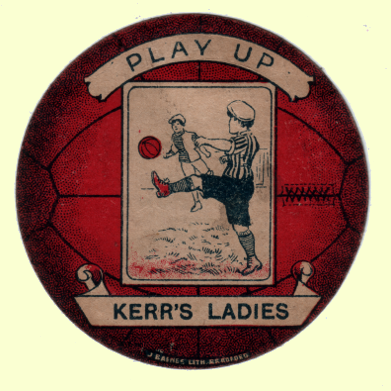
Dick, Kerr Ladies
- same English team but another Scottish story?
On a recent visit the the Football Museum in Manchester, called the "National" but actually only English, one of the exhibits to catch the eye was was that on the pioneering, women's football team the Dick, Kerr Ladies or as it shown above, simply Kerr's Ladies, with special notice to the comma and then the apostrophe. Two things struck. The first was the name itself. The second that the team was one founded from the workers at the Preston factory to represent the company and was sponsored by it, the players receiving 10 shillings (equivalent today of £100) per match. And one thing intrigued. Whilst the club itself continued after the 1921 English FA ban on the women's game, indeed did so for another forty years as Preston Ladies, the company subsidy continued before it was ended in 1925. The question was why and in the answer perhaps hangs a connecting tale.
First there is the company name. Dick, Kerr does not sound Preston. And that is because it is not. It had been founded in 1854 as W.B. Dick and Co., the W.B. standing for William Bruce, Oil Refiner, and in Glasgow. In fact William Bruce Dick had been born in Maybole in Ayrshire, the son of a cotton weaver. But he had moved to Glasgow, there prospering and where in 1851 his elder sister, Margaret, had married a silk, wool and cotton manufacturer, John Kerr.
John Kerr, in fact John Kerr Snr., would die in 1856 at just thirty-six but by then had had four children, John Kerr Jnr, born in Glasgow in 1852, being the second. And this younger John Kerr would eventually go on by 1871 to Glasgow University, marry Helen Melville in Falkirk in 1877 and by 1879 be living in Putney in London as an Iron Merchant. However, in 1883 William Dick at fifty-three clearly asked his nephew to join his business with a change of name to Dick, Kerr & Co, and a period of expansion soon resulting. In 1885 the new entity took on the Britannia Works that was just by the station in Kilmarnock, there to produce gas-engines, then branching out into trams and trains, opening its own foundry, still in Killy in 1890. But trams in particular were electrifying and in 1893 a further plant with that expertise was acquired in Preston in Lancashire and, whilst in 1891 Kerr was still in Putney and now an Engineer/Contractor, by 1901 he was back in Scotland; in Athelstane in East Lothian, a Mechanical Engineer with an interest in politics. In 1900 he had stood to be MP locally for Haddingtonshire. He was unsuccessful. But he stood again in 1903 in a by-election this time in Preston and won. By that time he was probably also staying in the town for, although he lost the seat in 1906, his mother, would in 1907 be living there on her death in Blackpool, with incidentally William Dick, her brother, having passed away two years earlier and leaving the equivalent today of £24 million.
However, whilst the Preston factory, which had become factories, appears to have been increasingly the centre of electrical manufacture with the coming of The Great War it would convert to producing planes and munitions. And as the men, especially from 1915, were called to fight, the work-force became increasingly female and from it, from them, would in 1917 emerge the essentially teenagers' football team that would rapidly become both very well-known and successful.
The genesis of the team seems to have been organic and Preston was a town with already a long, footballing history but why the sponsorship, which at perhaps a total of £1500-2,000 a match and in 1918 fifteen matches, so perhaps £30,000 plus per annum in today's terms would probably have had to have been authorised from the top, in fact by Kerr himself. And here we have both a possible explanation and confirmation.
With regard to the former John Kerr was a Glaswegian born in 1852. In 1872 he would have been twenty as football in the city exploded around him. In 1877 he would have been twenty-five as the game spread east and north. As a Scot in that era he could not have been unaffected. He would have been swept up. He may well even have played so when a football team, likely to raise morale that would be so successful that it went on, despite defeat in Scotland famously by Rutherglen Ladies (see: The BBC Documentary), to proclaim and market itself as "World Champions", emerged from his factory, albeit in Lancashire, why would he not be enthused, indeed make it happen long-term with an on-going contribution. And then there is the fact that Kerr himself seems from the ending of the War, he aged sixty-five, to have gradually stepped back. The Kilmarnock site, the last business in Scotland itself, was sold in 1919 and Dick, Kerr & Co became the not the Scottish but the English Electric Company, hence with "Kerr's Ladies" it from that point becoming both almost personal and marking from 1921 a wee act of Scots defiance. Whilst the English FA's ban on the women's game came into force, the Scottish FA for once did not follow suit, at least not for another generation. And nor did John Kerr.
And as to the latter, when in January 1925 in Frinton in Essex and as a Retired Engineer John Kerr himself died, aged 72, with him no longer there to sign the cheque that same year the company subsidy would be rapidly removed. Coincidence perhaps, but then maybe not.
Back to the SFHG Home page